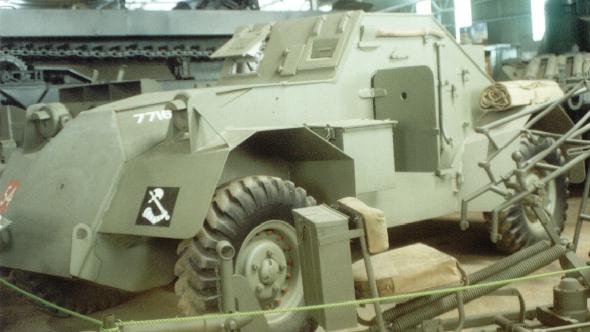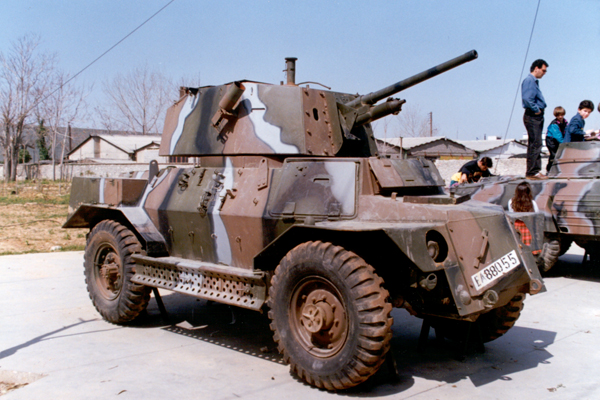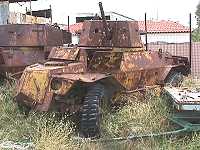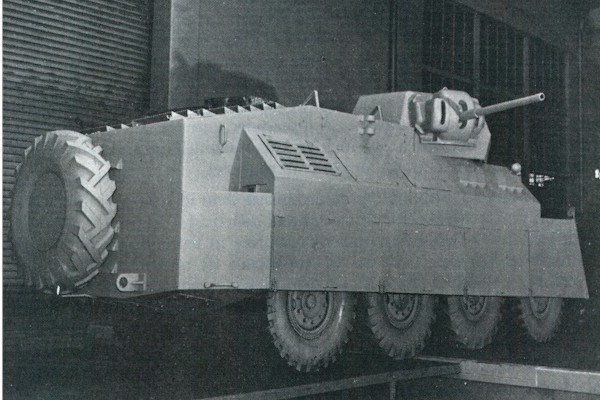| Marmon-Herrington Military Vehicles | ||||
| • Introduction | ||||
All-Wheel Drive Conversion kits:
|
||||
Tracked vehicles:
|
||||
In service:
|
||||
| Links | ||||
|
Marmon-Herrington All-Wheel Drive Conversion Kits |
|
|
|
|
|
|
|
The South Africans referred to the vehicle as the "South African Reconnaissance Car, Mark -" while the British referred to the vehicle as "Armoured Cars, Marmon-Herrington, Mark -". The South African name for the vehicle is a more accurately description. There were actually eight versions of the South African Reconnaissance Car. The last three (Mk VI, VII, VIII) were produced as prototypes only. Also, the quantity of eight includes treating the Mark IV and the Mark IVF as different versions. Final assembly of these armoured cars was accomplished by the Dorman Long structural steel company. Armour plate was made by the South African Iron & Steel Industrial Corporation. Prior to the Mark IV, the chassis was assembled by Ford Motor Company of South Africa (Pty.) using chassis components imported from Canada and based upon the pre-war Ford 3 ton lorry. The chassis was modified to four wheel drive using Marmon-Herrington supplied conversion kits. In the Mark IV, the M-H automotive components were mounted directly on the armoured hull. The Mark IVF used automotive components from Canadian Ford F60L 4 wheel drive 3 ton lorry chassis instead of M-H components. This was due to major difficulties in getting M-H components in 1942. Armament came from the UK except for the .30 cal. Browning machine guns on the Mark IV and later models. Please note that the M-H did NOT supply the turret and armour. While M-H did manufacture armoured cars during the 1930's in very small quantities, its main product were these 4 wheel drive conversion kits. It is also interesting that the Mark IVF was called the "Armoured Car, Marmon-Herrington, Mark IVF" by the British when there was no Marmon-Herrington components in the vehicle at all. The Mark I was actually a 2 wheel drive front engined vehicle. It only served in the South African "Union Defence Force". A total of 113 were built. Armament consisted of a single Vickers .303 MMG in a circular turret and a .303 Vickers mounted on the left hand side. Initial delivery was May 1940. The Mark II was a four wheel drive front engined vehicle. It served with both the UDF and British forces. It was initially delivered to UDF armoured car companies in November 1940 while the first units in the Middle East received them in March 1941. A total of 887 Mark II were built. Deliveries ended in May 1941. Armament was initially that of the Mark I. However, the turret and armament were subsequently changed for those serving in the Middle East to a flat faced turret mounting a .55 cal. Boys ATR and a Bren LMG. There were pintle mountings on the front roof for an additional Bren LMG and a pintle mounting for a Vickers MMG at the rear of the turret. However, it appears that the second Bren LMG was rarely carried. The Mark III was very similar to the Mark II in appearance. However, it had a shorter wheel base (117 inches instead of 134 inches). Armament was the same as the Mark II on Middle East service. A total of 2,630 were produced with deliveries from May 1941 through August 1942.
There were two versions of the Mark IV. These were the Mark IV itself and the Mark IVF.
The Mark V was a vehicle that employed a suspension system of four rigid axles with power applied only to four of the eight wheels. At the initial tests trials in February 1942 the vehicle weighed 16 tons without armour, this gave an acceptable performance on road and other surfaces, however in soft sand the vehicle soon bogged down. The Mark VI was an eight wheel armoured car similar to the German heavy armoured cars. It was a rear-engined vehicle that used 2 sets of M-H 4x4 components and mounted 2 Ford V-8 engines. Armament for prototype #1 was a 2 pdr gun with a coaxial .30 Browning MG and twin .30 Browning MG on a ring mount on the top of the vehicle. Prototype #2 had a 6 pdr gun, a coaxial 7.92 mm Besa and a .50 cal. Browning in an AA mount on the top of the turret. It was designed for use in the North African desert but was not ready in time. 750 cars were ordered in 1942 for delivery but delays in the receipt of automotive parts from North America held back production of all armoured cars in 1942. By the time production was ready in 1943, it was clear that this design was no longer needed. Production was cancelled. The Mark VII was a front engined car without a turret. Armament was a Vickers .303 cal. MMG on an open ring mounting. It was not produced beyond the prototypes. The Mark VIII was also a conventional front engined vehicle but mounting a 2 pdr gun in a long turret. This also failed to get beyond the prototype stage. British/Commonwealth
units that used the Mark II and/or Mark III versions of this vehicle in
the Middle East included the King's Dragoon Guards, the Royal Dragoons,
the 8th King's Royal Irish Hussars, the 3rd South African Reconnaissance
Battalion, the 4th South African Armoured Car Regiment, the 6th South African
Armoured Car Regiment and the 7th South African Reconnaissance Battalion.
There may have been others. In addition, the 3rd Indian Cavalry regiment
had a small number of these vehicles (not sure if Mark II or Mark III)
in Malaya in 1941/1942.
|
|
|
| Read about the Australian LP-4 Armoured Car in Bob Mosely's articles
The Only One Left In The World and
The Only One Left In The World (Or So I Thought). The LP-4 was based
on a 1939 Ford chassis with a Marmon-Herrington All Wheel Drive kit.
Only nine LP-4's were built, of which two survive: C-6280 "Bandicoot" is operational and road registered and is on permanent display in the South Australian Military Vehicle Museum; C-6281 "Porcupine" is incomplete and unrestored. bandicoot bandicoot2 |
|
|
|
|

See The Australian W.W.II. Page |
|
|
|
|
|
[ Introduction
| Trucks | Armoured Cars
| Tractors | Tanks |
Commonwealth
| Latin America | Netherlands
| USA | Links]
Site built by Hanno Spoelstra




